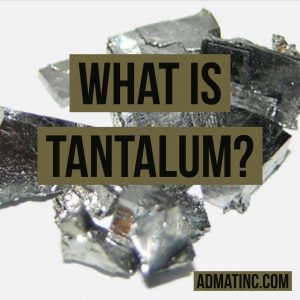 Tantalum (Ta) is an unsung hero in modern metallurgy. First discovered by the Swedish chemist Anders Ekeberg in 1802, this versatile metal has become essential to numerous industries over the years.
Tantalum (Ta) is an unsung hero in modern metallurgy. First discovered by the Swedish chemist Anders Ekeberg in 1802, this versatile metal has become essential to numerous industries over the years.
Raw tantalum rarely occurs in nature. Instead, it is typically found in the ore columbite-tantalite (usually referred to as coltan). Once extracted, pure tantalum is a hard blue-gray lustrous metal.
Since its discovery, tantalum has been used in a number of applications. In the 21st century, it has become a crucial element in the electronics industry, with over 75% of electronics containing tantalum in some form. In particular, engineers have been able to take advantage of some of tantalum’s properties to make capacitors and other components smaller and more efficient.
Properties of Tantalum
Tantalum has several unique characteristics that have led to its increased use in the 21st century. It is a highly stable metal that is almost immune to chemical degradation at temperatures lower than 302 °F (159 °C). In addition, it exhibits high levels of corrosion resistance when it comes into contact with air and moisture.
Like most metals, tantalum forms a thin but dense protective oxide layer (Ta2O5) when exposed to the atmosphere. This oxide layer firmly adheres to the surface of the metal, acting as a barrier which protects the underlying metal from further corrosion.
Tantalum belongs to a class of metals known as refractory metals, which are defined by their strong resistance to heat and wear. It has a melting point of 5,463 °F (2,996 °C), the fourth highest of all metals.
In terms of mechanical properties, tantalum is highly ductile, making it suitable for processes such as bending, stamping, and pressing. When combined with other metals, it can produce alloys with enhanced strength and higher melting points.
Common Uses of Tantalum
Tantalum is generally used in applications that require increased heat, corrosion, and chemical resistance. Below is a list of the commonly available forms of tantalum and their most common uses.
- Sheet/Plate – Tantalum’s high melting point makes it ideal for high-temperature applications. In sheet form, it is commonly used in linings for columns, vessels, tanks, heat exchangers, and vacuum furnace parts. Thin sheets can also be used for anti-corrosion cladding, repairs, and reinforcement of existing
- Rod/Wire – Tantalum is also known for its biocompatibility. In other words, it is a nonirritating element that is not affected by bodily fluids. This property makes tantalum wires a popular material for prosthetic implants and other medical devices. In addition, tantalum wires are commonly used in vacuum furnace heating elements, chlorinator springs, light bulb elements, and chemical processing equipment.
- Powder – In its powder form, tantalum is used to produce electrical circuits, capacitors, and resistors, primarily because its superior capacitance allows it to hold more charge per gram than other materials. This has made it possible to develop smaller electrical parts and, by extension, smaller electrical devices.
- Tube – Because of their heightened resistance to corrosion, tantalum tubes are often employed in the chemical, petrochemical, and pharmaceutical industries for the processing of compounds that may weaken or destroy other metals. Columns, stacks, and piping are just some of the products constructed from tantalum tubing in these industries.
- Strips and foils – Similar to sheets, tantalum strips and foils can be used as liners in vacuum furnaces and heat insulation applications. Thin-gauge tantalum strips can also be deep drawn to manufacture crucibles, cups, and other inert laboratory equipment.
Tantalum Physical & General Properties
- Element Category – Transition Metals
- Phase – Solid
- Symbol – Ta
- Number – 73
- STD Atomic Weight – 180.94788
- Crystal Structure – Body Centered Cubic
- Melting Temperature – 5463° F, 3017° C, 3290 K
- Boiling Temperature – 9856° F, 5458° C, 5731 K
- Electrical Resistivity – 20° C, 131 nΩ·m
- Thermal Conductivity – 300 K, 57.5 W·m−1·K−1
- Thermal Expansion – 25°C, 6.3 µm·m−1·K−1
Standard Specifications
- Tantalum Ingot – ASTM B364
- Tantalum Rod and Wire – ASTM B365
- Tantalum Tubing – ASTM B521
- Tantalum Sheet, Plate, Strip and Foil – ASTM B708
- Medical Grade Tantalum – ASTM F560
Common Tantalum Alloys (UNS Codes)
- Unalloyed Tantalum (EB Melted) – R005200
- Unalloyed Tantalum (Powder Metallurgy Grade) – R05400
- Tantalum 2.5% Tungsten – R05252
- Tantalum 10% Tungsten – R05255
- Tantalum 7.5% Tungsten – Spring Grade
- Grain Stabilized – Furnace Grain
Commercial Grade ASTM Tantalum Purities
- 99.5% Pure 3N5
- 99.9% Pure 4N
- 99.995% Pure 4N5
- 99.999% Pure 5N
If you’re interested in discussing how tantalum can be used for your application, please feel free to contact our technical team directly.

